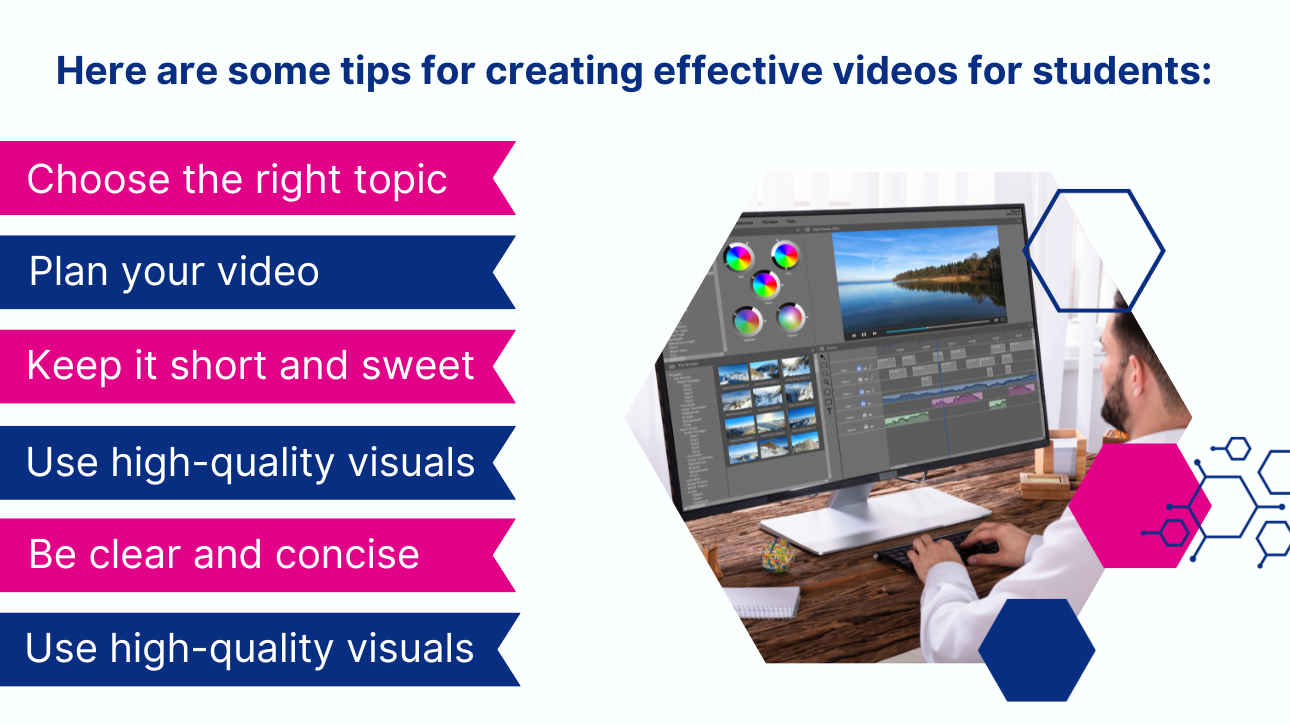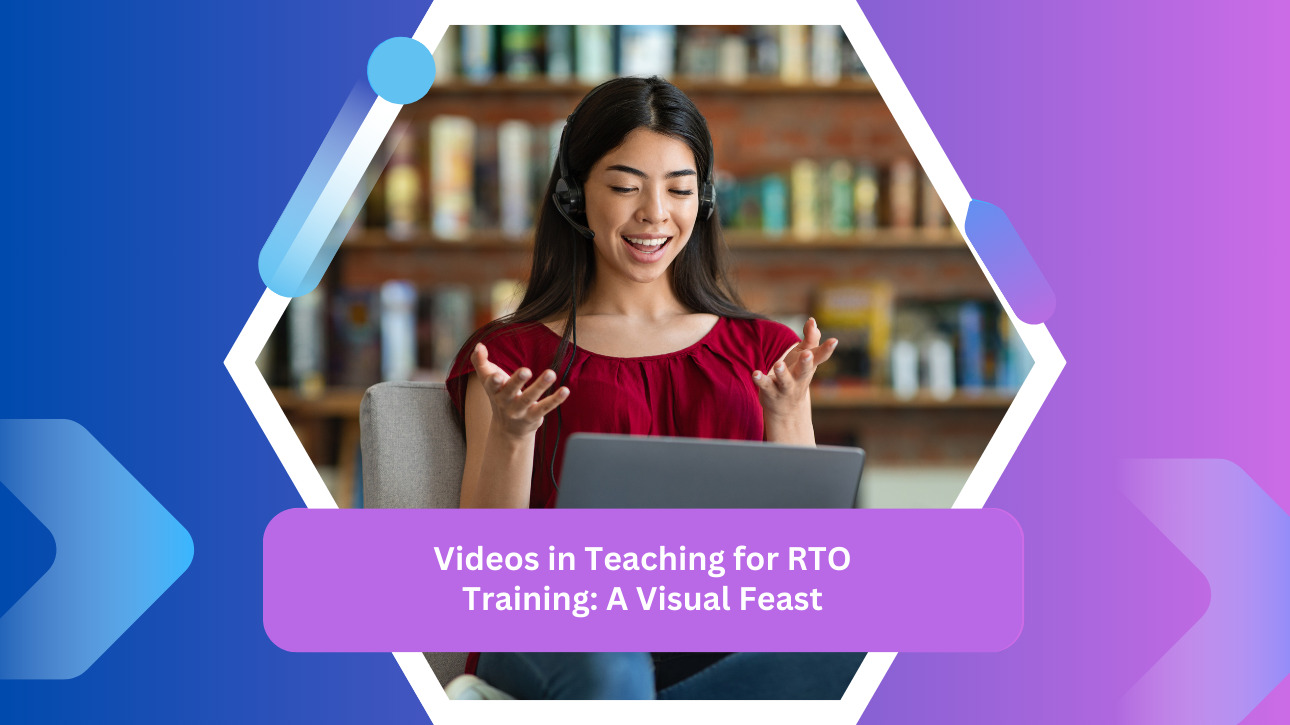The world of education is constantly evolving, and RTOs are no exception. As technology advances, new and innovative ways to deliver effective learning experiences emerge. Videos are one of the most powerful tools that RTOs can use to engage students and promote active learning.
When used effectively, videos can help students to:
- Visualise complex concepts
- Learn new skills at their own pace
- Receive feedback from experts
- Develop critical thinking skills
- Apply what they are learning to real-world situations
Importance of using Videos in Teaching for RTOs
Videos are an important tool for teaching in RTOs because they can:
- Improve student engagement and motivation: Videos can be more engaging and motivating than traditional teaching methods, such as lectures and readings. This is because videos can capture student’s attention with their visuals, sound, and movement.
- Help students visualise concepts and learn new skills: Videos can help students to visualise complex concepts and learn new skills in a more effective way than traditional teaching methods. This is because videos can break down complex concepts into smaller, more manageable chunks, and they can provide students with step-by-step instructions for learning new skills.
- Provide students with different perspectives on a topic: Videos can help students to see a topic from different perspectives. This is because videos can feature experts, practitioners, and people with personal experiences to share.
- Help students to develop critical thinking skills: Videos can help students to develop critical thinking skills by prompting them to ask questions, analyse information, and form their own opinions.
Creating videos in Teaching for Students
Here are some tips for creating effective videos for students:

Here are some tips for creating effective videos for students:
- Choose the right topic: Make sure the topic of your video is relevant to your student’s needs and interests.
- Plan your video: Before you start filming, take some time to plan your video. This includes thinking about the key points you want to make, the visuals you want to use, and the sequence of your video.
- Keep it short and sweet: Students are more likely to watch and engage with shorter videos. Aim for videos that are no longer than 10 minutes long.
- Use high-quality visuals: Visuals are essential for engaging students and helping them learn. Use high-quality images and videos in your videos.
- Be clear and concise: Speak clearly and concisely in your videos. Avoid using jargon and technical terms that your students may not understand.
- Add personality: Let your personality shine through in your videos. This will help you connect with your students and make your videos more engaging.
Videos in Teaching – Creation Techniques
Here are some popular video creation techniques that you can use in your videos:
- Piece to camera: This is where you speak directly to the camera. This is a great way to introduce yourself, explain a concept, or answer a student’s question.
- Screen casting: This is where you record your computer screen. This is a great way to show students how to do something, such as how to use a software program or how to solve a math problem.
- Animation can be used to explain complex concepts in a simple and engaging way. There are many different animation tools available, such as Powtoon and Biteable.
- Green screen videos: Green screen videos allow you to superimpose yourself onto any background. This can be a great way to create creative and engaging videos.
Video Editing Software for Videos in Teaching
Once you have filmed your video, you will need to edit it. There are many different video editing software programs available, both free and paid. Some popular video editing software programs include:
- Cloud-based: WeVideo
- Desktop: Adobe Premiere Pro, Final Cut Pro, iMovie
- Mobile: Splice, InShot, KineMaster
How to Share your Videos in Teaching with Others
Once you have edited your video, you can share it with your students in a number of ways. You can upload your video to YouTube or Vimeo and share the link with your students. You can also embed your video on your website or blog.
Using Videos in Teaching that Others have Made
There are many great educational videos available online. You can use these videos in your classroom by embedding them on your website or blog, or by sharing the link with your students.
When choosing videos for your students, it is important to make sure that the videos are accurate, relevant, and appropriate for their age and learning level. You should also make sure that the videos are from a reputable source.
Free Online Video Libraries for Videos in Teaching
Here are some free online video libraries that you can use to find educational videos for your students:

Conclusion
Videos are one of the most important aspects of modern education. They offer a number of benefits for RTO trainers and students alike, including improved student engagement, enhanced learning outcomes, increased flexibility and personalisation, and reduced costs.
Are you an RTO looking for quality RTO training resources? If yes, then VET Resources is your partner. We also have a YouTube Channel with videos on RTO related matters. We also offer free consultation to RTOs. For further information please contact here.
Frequently Asked Questions (FAQs)
Q.1. What are the benefits of using online educational videos in RTO teaching?
A.1. There are many benefits to using online educational videos in RTO teaching, including:
- Increased student engagement and motivation
- Enhanced learning outcomes
- Increased flexibility and personalisation
- Reduced costs
Q.2. What are some popular online video tools for RTO trainers?
A.2. Some popular online video tools for RTO trainers include:
- YouTube
- Vimeo
- Loom
- Screencast-O-Matic
- Camtasia Studio
Q.3. How can I ensure that my online educational videos are aligned with my intended learning outcomes?
A.3. To ensure that your online educational videos are aligned with your intended learning outcomes, you should:
- Start by identifying the key learning objectives for your lesson.
- Choose video content that is relevant to your learning objectives.
- Create questions and activities that help students to assess their understanding of the video content.
- Provide students with feedback on their progress.
Q.4. How can I use videos effectively in hybrid learning models?
A.4. To use videos effectively in hybrid learning models, you should:
- Choose videos that are relevant to the content you are teaching in class.
- Use videos to introduce new concepts or to review previously taught material.
- Ask students to watch videos at home and to come to class prepared to discuss the video content.
- Use in-class time to answer questions, to facilitate discussions, and to provide students with hands-on activities.
Q.5. How can I integrate videos into my learning management system (LMS)?
A.5. Most LMS platforms allow you to integrate videos into your courses. To do this, you will need to upload the videos to your LMS or to a third-party video hosting service, such as YouTube or Vimeo. Once the videos have been uploaded, you can embed them in your LMS courses.
Q.6. What are some best practices for using videos effectively in teaching?
A.6. Some best practices for using videos effectively in teaching include:
- Use short videos. Students are more likely to watch and engage with shorter videos.
- Choose videos that are high quality. Videos should be well-lit and well-recorded.
- Use videos that are relevant to your students’ needs and interests. Videos should be engaging and motivating for students.
- Use videos to complement your other teaching methods. Videos should not be used to replace traditional teaching methods, such as lectures and discussions.
- Provide students with opportunities to interact with the videos. Ask students questions, have them take notes, or ask them to complete activities related to the video content.
Q.7. What are some examples of multimedia learning materials that I can use in my teaching?
A.7. Some examples of multimedia learning materials that you can use in your teaching include:
- Online educational videos
- Interactive presentations
- Simulations
- Virtual reality experiences
- Augmented reality experiences
Q.8. What are some effective communication skills that I can use when creating online educational videos?
A.8. Some effective communication skills that you can use when creating online educational videos include:
- Be clear and concise. Speak clearly and concisely in your videos. Avoid using jargon and technical terms that your students may not understand.
- Be enthusiastic and engaging. Let your personality shine through in your videos. This will help you connect with your students and make your videos more engaging.
- Use visuals effectively. Visuals are essential for engaging students and helping them learn. Use high-quality images and videos in your videos.
- Provide opportunities for interaction. Ask students questions, have them take notes, or ask them to complete activities related to the video content.
Q.9. What are some common types of errors that I should avoid when creating online educational videos?
A.9. Some common types of errors that you should avoid when creating online educational videos include:
- Technical errors, such as poor video quality or audio quality
- Content errors, such as inaccurate or outdated information
- Pedagogical errors, such as using ineffective teaching methods or failing to engage students
Disclaimer:
The information presented on the VET Resources blog is for general guidance only. While we strive for accuracy, we cannot guarantee the completeness or timeliness of the information. VET Resources is not responsible for any errors or omissions, or for the results obtained from the use of this information. Always consult a professional for advice tailored to your circumstances.






